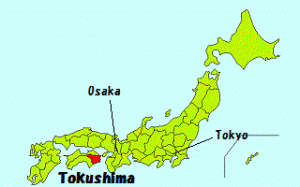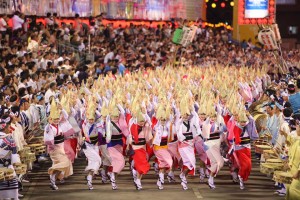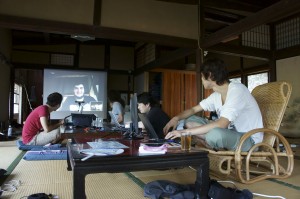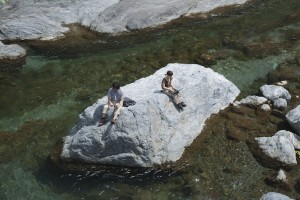 Tokushima Prefecture, on the eastern side of the island of Shikoku, is connected to mainland Japan by the Akashi-Kaikyo and Naruto Bridges, and can be reached from Osaka in two and a half hours by highway bus. Tokushima is home of the world-famous Awa Dance festival and abounds in beautiful natural scenery.
Tokushima Prefecture, on the eastern side of the island of Shikoku, is connected to mainland Japan by the Akashi-Kaikyo and Naruto Bridges, and can be reached from Osaka in two and a half hours by highway bus. Tokushima is home of the world-famous Awa Dance festival and abounds in beautiful natural scenery.
 Awa Odori
Awa Odori
The Awa Dance (Awa Odori) is Tokushima’s largest annual event and boasts a history of over 400 years. The dance is held in many locations throughout the prefecture as the main event of summer, in association with the traditional Bon Festival. By far the most popular area is in Tokushima City where the dance draws some 1.3 million visitors over the period of August 12 to 15, bringing the city center alive with excitement.
Ohenro
The Shikoku pilgrimage circuit, called “Ohenro” in Japanese, links 88 temples said to have been founded around the year 815 by the famous Buddhist monk Kobo Daishi (Kukai) to protect pilgrims and others from misfortune. Pilgrims usually visit the temples in their numbered order, making a clockwise circle around the island of Shikoku.
 Many people take the pilgrimage as a journey of self-discovery or of healing.
Many people take the pilgrimage as a journey of self-discovery or of healing.
Link to Tokushima English Tourist Info
Challenges in Tokushima – Satellite Office Project
 One of the main challenges undertaken in Tokushima is to revitalize rural areas. Like many local authorities in Japan, Tokushima is also facing a depopulation problem. Kamiyama Town however, whose population is under 6,000, located in a typical farming area in Tokushima Prefecture, is attracting people from outside through an original initiative.
One of the main challenges undertaken in Tokushima is to revitalize rural areas. Like many local authorities in Japan, Tokushima is also facing a depopulation problem. Kamiyama Town however, whose population is under 6,000, located in a typical farming area in Tokushima Prefecture, is attracting people from outside through an original initiative.
Two keywords for Tokushima are “green” and “fibre optics”. Kamiyama Town is promoting its beautiful natural environment, together with its optical fibre network, boasting that people can get both relief from nature and business from super fast fiber optic connections. Many firms have opened a satellite office there, and the enthusiasm of those already recently settled in the area is causing more interest. The town is now aiming to be a place where both residents and the town can be revitalised under the project with the name of ‘Satellite Office Project’
 After to the impact of the Great East Japan Earthquake in 2011, companies are looking to diversify office functions away from the metropolitan areas, and want to transfer and distribute office roles to western Japan. ICT companies in particular, unrestricted by time and location, are taking advantage of information and communication technology with strategies such as mobile work, teleworking and satellite offices, and there is growing momentum to review the traditional way of working in other sectors.
After to the impact of the Great East Japan Earthquake in 2011, companies are looking to diversify office functions away from the metropolitan areas, and want to transfer and distribute office roles to western Japan. ICT companies in particular, unrestricted by time and location, are taking advantage of information and communication technology with strategies such as mobile work, teleworking and satellite offices, and there is growing momentum to review the traditional way of working in other sectors.
The ‘Tokushima village regeneration project’ is a completely new village regeneration model, with satellite offices created for metropolitan based companies using renovated houses in the prefecture, which has many depopulated towns and villages, with video conferencing to the Tokyo metropolis, and the hamlets used as hubs for companies working through social media such as Facebook. Through these initial trials work environments have been confirmed as sustainable, and with broadband development in every corner of the prefecture, high speed fibre is standard across Tokushima Prefecture.
 As well as companies establishing satellite offices as part of risk reduction for natural disasters, and further to improved employee mental health and access to physical recreation, there was also been seen the advancement of a ‘volunteer spirit’ of company staff in the village communities.
As well as companies establishing satellite offices as part of risk reduction for natural disasters, and further to improved employee mental health and access to physical recreation, there was also been seen the advancement of a ‘volunteer spirit’ of company staff in the village communities.
On the local side, longtime residents have seen the results of young professionals moving into the area and are seeing an expansion of the sales and marketing of traditional goods, together with rising attractiveness of the area through the use of social media such as Twitter and Facebook, leading to job creation in areas as traditional industries see a resurgence. Based on these results, 19 companies have established offices in the area (March 2014 figures). This is a public-private collaboration to ensure the prefecture has a means of moving into the future, further working to resolve issues such as the development of public wireless LAN, and actively promote efforts to establish further satellite offices.
Kamiya Project, to build a self-sustaining and economically independent community
An Experiment From Green Valley in Kamiyama Town, Tokushima, Japan: How to Make Depopulated Areas Attractive (Japan For Sustainability NPO article)

